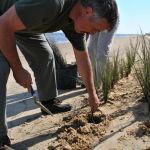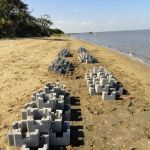Winyah Bay South Island Living Shoreline
Description
The South Island project included 1,000 castle blocks stacked into ten sets of configurations installed on the 0’ MLW line in partnership with the South Carolina Department of Natural Resources (SC DNR) staff that manage the Yawkey property and students from the Horry-Georgetown Technical College (HGTC). The installation and planting were conducted approximately one month apart. A tropical storm in the Atlantic passed the SC coast shortly after installation and disrupted most of the configurations and covered the bottom tier of castles with sand. The planting occurred shortly after and plants were installed on the shoreward side of the castles. An intern, David McColl, from the HGTC was hired to monitor the project site on South Island for approximately 12 months. David’s report includes information on the loss of the Spartina alterniflora that were planted, with the exception of the most northern sites, and the slow settlement of oysters on the castles. We concluded that the high energy in the system runs along the stretch of beach on South Island and diverges in towards the middle of the bay just before the location of our most northern set of sites. We assumed this high energy tidal flow was partially the cause of the lack of significant oyster spat settlement and washing away the newly planted marsh grasses. Overtime, the sand has been partially washed away to uncover a portion of the bottom tier again, which could also be due to the high tidal energy situation. During David’s monitoring period we did notice larger oysters growing on items (i.e., tires, old concrete, etc.) haphazardly located below the MLW line. Based on those observations I decided to explore a new installation on North Island and site the castles below the MLW line. When considering the large amount of freshwater that enters Winyah Bay via the multiple rivers, a deeper location makes sense for better oyster growth due to the siting under the sheet flow of freshwater entering the system. Objectives: Successful Habitat Restoration Environmental Benefits Human Well-being / Quality of Life
Technical Details
0.02479 Oyster Reef/Shell Bottom Restored
Techniques: Oyster Reef Construction
Data Collected: Oyster surveys Water quality Stem counts Sediment accretion
Species: Crassostrea virginica
Funding
Partners: Coastal Carolina University United States Fish and Wildlife Service South Carolina Department of Natural Resources Horry Georgetown Technical College
Contact
- Joy Brown, SCFO, TNC
- This email address is being protected from spambots. You need JavaScript enabled to view it.

